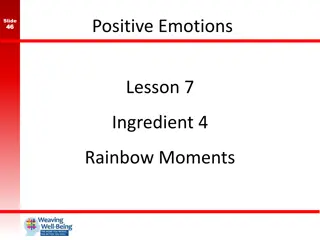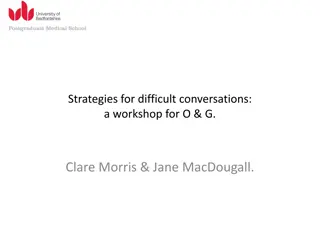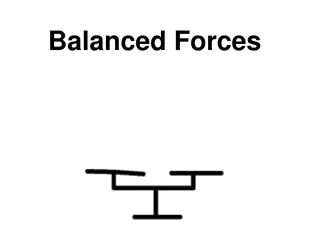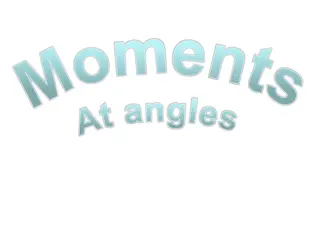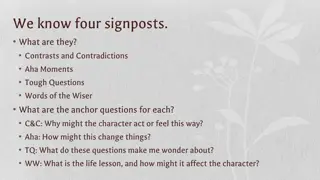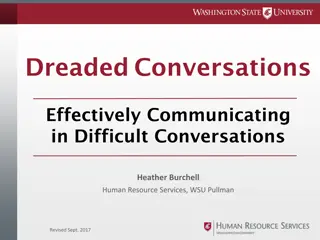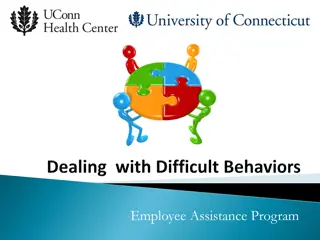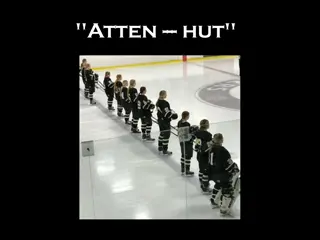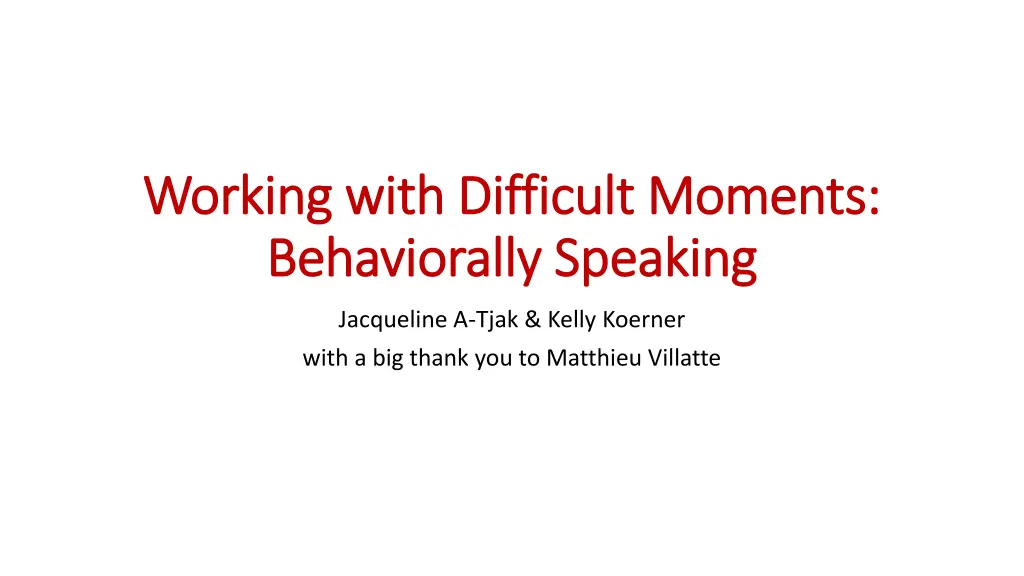
Understanding and Managing Difficult Emotions in Therapy
Explore techniques to navigate challenging moments in therapy sessions, focusing on enhancing emotional sensitivity, validation, and control strategies. Learn how to create a supportive environment for clients with histories of emotional dysregulation.
Download Presentation

Please find below an Image/Link to download the presentation.
The content on the website is provided AS IS for your information and personal use only. It may not be sold, licensed, or shared on other websites without obtaining consent from the author. If you encounter any issues during the download, it is possible that the publisher has removed the file from their server.
You are allowed to download the files provided on this website for personal or commercial use, subject to the condition that they are used lawfully. All files are the property of their respective owners.
The content on the website is provided AS IS for your information and personal use only. It may not be sold, licensed, or shared on other websites without obtaining consent from the author.
E N D
Presentation Transcript
Working with Difficult Moments: Working with Difficult Moments: Behaviorally Speaking Behaviorally Speaking Jacqueline A-Tjak & Kelly Koerner with a big thank you to Matthieu Villatte
Aim Aim of of this this workshop workshop Increase your sensitivity for non-verbal signals from your client Experience the power of validation Understand validation as a behavioral intervention Understand difficult emotion (functional analysis) Work with difficult emotion: informal exposure and emotion regulation
Difficult moments can arise Difficult moments can arise When people have histories of continuous unpredictable responses to their behavior (unsafe attachment, invalidating environments), they are easily overwhelmed by their emotions. The slightest signs of rejection or faults can function as signs of threat They can only regulate their emotions by drastic, toxic control efforts To learn new ways of relating to their emotions they need a predictable and controllable environment.
Prediction & Control
Setting up a context of Setting up a context of prediction prediction and and control control A therapist who is sensitive to emotions and needs, that cannot be expressed openly and fully (other-as-process) A therapist who is willing to take responsibility for emotional disregulation of the client (willingness and committed action) A therapist who is transparent about her own feelings,thoughts and needs (self-as-process) A therapist who asks for permission
Setting up a context of Setting up a context of prediction prediction and and control control A therapist who is accepting, defused, present, committed A therapist who validates the perspective of the client
Whats hard for me right now What s hard for me right now
Mindfulness purposeful attention without judgment to the present moment Can I be with this? What is happening right now?
whiff of not enough mental anguish when what we touch, see, hear, contact habits of: aversion/craving fix it so feel better Outside skin Inside skin gives rise to pain give rise to suffering
During difficult moments What is happening right now? habits of: aversion/craving fix it so feel better movie of me Can I be with this? Outside skin Inside skin
T attends to patterns of regulating threat and their unintended consequences, focusing on acceptance C T Radiating warmth, we just find ourselves here, it s not your fault stance
As C becomes more flexible again, T attends to assessing and moving toward change C T
Validation behaviorally speaking Validation behaviorally speaking To affirm the coherence of the story (network) of the other person = other-as-context: seeing the perspective of the cli nt = acceptance: accepting the perspective of the cli nt as valid = defusion from your own story as more true . = defusion from being right Creates a context to open up to new information
I. I. The bigger picture: shedding new light The bigger picture: shedding new light NOW, we add new information to the network: = function: how does it work, short term-long term = asking for the history: have you had that thought before? = disconfirming experiences in the past = metaphor = socratic dialogue
II. Labeling II. Labeling Calling a spade a spade = naming, categorizing: this is fear, this is a thought = creating a hierarchical relationship between this emotion and all emotions Calling your own spade a spade = modelling = creating a safe, accepting, defused context = creating other/self-as-context
III. Alternative reaction III. Alternative reaction Bringing attention to the bodily felt sensation (from fusion with there- and-then to here-and-now) Asking questions about alternatives, for instance valued behavior: what could you do while you have this thought or emotion?
IV. Harvesting IV. Harvesting Is there a difference between how you felt before and after our discussion? (help noticing that a transformation of stimulusfunctions took place) More control Self acceptance Validation New Light Overwhelming emotion
First exercise Have a therapist-client interaction Client tells about a disturbing experience Therapist tries to make the client see, that the client is seeing this the wrong way Observer: notice the non-verbal behavior of both client and therapist: tone, volume, posture, pace, facial expression, gestures, tension.
Second exercise Have a therapist-client interaction Client tells about a disturbing experience Observer: notice the non-verbal behavior Therapist starts with validation = It is logical that = I understand that you = If I were you, I would also . = It is as if .. (metaphor)
AND When clients opens up, therapist moves into the bigger picture , labeling , or alternative reaction How could you know that it was the right time to move on to adding new information ?
Third exercise Have a therapist-client interaction Client tells about a disturbing experience Therapist starts with validation Now, therapist moves into the bigger picture , labeling , or alternative reaction Lastly, the therapist harvests Observer: notice the non-verbal behavior How could you know that it was the right time to move on to harvesting?
Informal Exposure 1.Validation evokes other emotions (emotions re- organize us) 2.Block/discourage experiential avoidance and maladaptive emotion regulation in-session
With invalidation, we learn Expression elicits other s Discomfort, withdrawal, attack, incomprehension etc., etc., etc. Emotion fires Monitoring attending CHANGE Disrupts naturally organizing effect of emotion and information from emotion
whiff of not enough mental anguish when what we touch, see, hear, contact habits of: aversion/craving fix it so feel better Outside skin Inside skin gives rise to pain give rise to suffering
Over time, we learn Interrupt self and/or self- invalidate experience or expression (e.g., blunt, postpone, mute, mask, avoid, numb, secondary emotion, etc.) Secondary Emotion fires Anxious anticipation of invalidation Emotion fires Monitoring attending CHANGE Disrupts naturally organizing effect of emotion and information from emotion
Chain Analysis (aka functional analysis) Vulnerability factors Precipitating Event(s) Consequences emotions vulnerability shame sadness fear 1. anger 2. self-contempt
I as contact with sensations from a particular location
You (or me) in a context overwhelmed calm Disappointed relieved irritated Sad disturbed
New cuevoila! Changed organism fear sad ANGRY Shame disturbed
New cuevoila! Changed organism fear sad Self-contempt Shame despair
this isnt helping madsad
Practice: Validate to Differentiate Emotion Blends of emotions may fire and muddle the naturally adaptive action urges. Validate to establish new stimulus control. In context of overwhelmed vulnerability Sadness, fear, shame, habitual response to threat This isn t helping Self-contempt/collapse This isn t helping Attack
Set up C: This isn t helping (with either self-contempt or attack T) T: VIVIDLY validate fear, validate anger, validate sadness, whatever emotion is primary and adaptive. Watch to see what natural adaptive action urges arise
Example phrasing Clients any effective lines your therapists have said?
Gently block avoidance(CRB1) to shape flexibility (CRB2) Cue is sensation of overwhelm/vulnerability Present cue Gently block avoidance Increase inhibitory learning (i.e., help client build new meaning about the cue, learn cue can be tolerated, worked with, habitual avoidance isn t needed)
Informal exposure Upgrades (1)____ T EXPLICITLY EXPOSES C TO EMOTION CUES in session (e.g., imaginal exposure, engaging in behaviors known to elicit unjustified emotions, role-play, eliciting new behavior, opposite action) (2)____ T BLOCKS ACTION TENDENCIES associated with C's problem emotions. a>___ T prevents C from engaging in emotional avoidance. b>___ T blocks C's tendency to escape/avoid when feeling afraid. c>___ T blocks C's tendency to hide or withdraw when feeling shame. d>___ T blocks C's tendency to repair or self-punish when feeling unjustified guilt. e>___ T blocks C's tendency to hostile and aggressive responses; f>___ T blocks active-passivity. (4)____ T ENHANCES C's SENSE OF CONTROL over adverse emotional situations. a>___ T designs exposure treatment collaboratively with C. b>___ T instructs C at that he/she has ultimate control over stimuli and can end exposure at any time. c>___ T gets C to collaborate in staying in emotional stimulus condition as long as possible. d>___ T helps C leave or escape situations voluntarily instead of automatically.
Example phrasing So let me ask: As I acknowledge how overwhelming this is What happens when I say that? Uh huh, you notice and you want to jump to ... So let s together linger here for a moment. The reason is, I m thinking you avoid being in this place, and you avoid it so consistently, and as a result it s like it becomes intolerable when you feel overwhelmed and we know how that leads to problems for you so let s slow down and practice just being here for a few moments. So if I really was disappointed, what would you feel? What do you notice? What goes through your mind? Etc.
Practice: Gently block CRB1 to shape CRB2 T begins session as usually do C: as you bring up first topic, you feel overwhelmed and begin avoiding (free form) T: help C by blocking avoidance, increase learning in presence of cue


